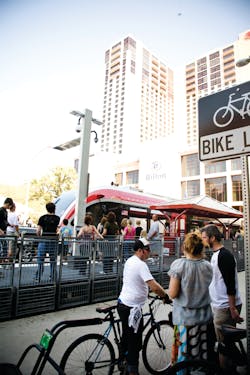Social Media During a Mega Event
The city of Austin, Texas welcomed its first Formula 1 U.S. Grand Prix this past November, where an estimated 200,000 visitors descended on downtown hotels, bars, restaurants, and of course, the brand new racetrack built on the outskirts of town.
To support what was sure to be a massive spike in public transit use, Capital Metro rolled out numerous enhancements to its regular service, including extended hours on MetroRail, increased frequency on MetroAiport service, a free circulator bus to move people around the urban core, and a mobile app that included maps and a trip planner.
Campaign goal was to raise awareness of availability of special service during Formula 1 by driving traffic to the special F1 website section, and increasing online communication about Capital Metro’s value as a transit provider during the busiest weekend in Austin’s history.
A crucial element of the communications plan — and one that proved well worth the sometimes intense effort involved — was the implementation of a robust social media campaign to assist out-of-town guests and local residents. From international visitors to the local news media, Capital Metro’s social media accounts were buzzing throughout the weekend event. Here are some highlights:
• During the three-day race weekend, Capital Metro monitored its social media presence on a dedicated basis — in both English and Spanish — 15 hours a day, oftentimes interacting with riders well past midnight as people hurried to catch the last train or bus of the day.
• Local news media stayed vigilant of the real-time postings being done, and played an important role in retweeting Capital Metro posts and providing updates via on-air segments. One such example was when the commuter train experienced a significant mechanical issue, resulting in a major service delay. Because the Cap Metro communications team had set-up a virtual “command center” beforehand with the Rail Operations team, it was able to relay updates in real time to those following the agency’s Twitter and Facebook accounts, including many local radio and TV reporters.
• Using the social media tool Hootsuite, Capital Metro was able to schedule regular informative postings throughout the day and night, such as Tweets that linked to the Formula 1 section of the agency’s website, info about the circulator bus, a link for downloading the mobile app, and race start times.
• Over the course of three days, Capital Metro put out 150 Tweets, had 100 retweets and received 521 new likes on Facebook.
Capital Metro used many strategies, including “liking” other influential Facebook pages where people went to reference F1 news (i.e. Circuit of the Americas, City of Austin, Austin-Bergstrom airport, Social Media Club), asking fans to write on our wall or send photos about their F1 adventures via transit, monitoring Twitter for posts about F1 parking, traffic, airport, etc and engaging followers with messages about taking transit, and posting about various F1 downtown events and which routes/train could take you there.
Throughout the Formula 1 weekend, it was the consistency in postings, quality of information and real-time service updates that seemed to delight riders.
Here’s a sampling of Tweets and Facebook posts:
• Fernando R: Great service yesterday. Thanks to downtown loop and #411 drivers at 12:00 am very kind and helpful. Fernando from Mty, Mexico (Nov. 17)
• Liam B: Hey Cap Metro thanks for keeping things moving downtown this weekend and for the extra trains. Job well done! (Nov. 17)
• Joe B: Gotta say, it appears that the city, Cap Metro, and other orgs are hitting a home run during #ATXF1! (Nov. 18)
